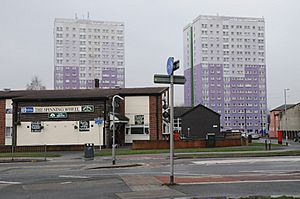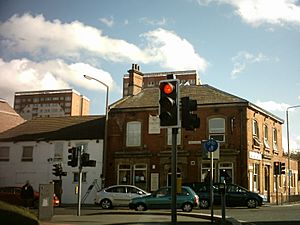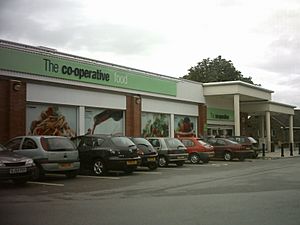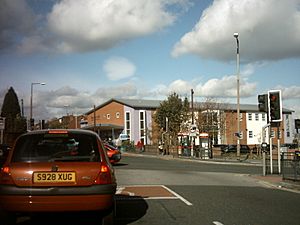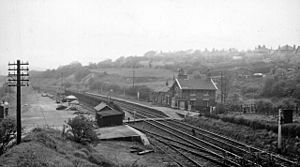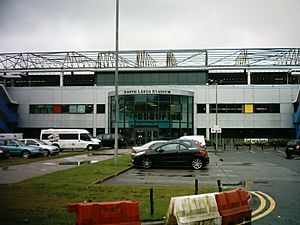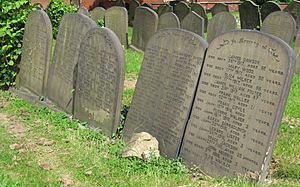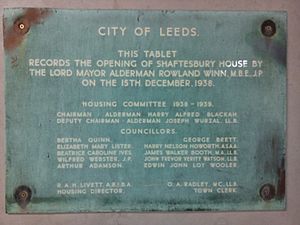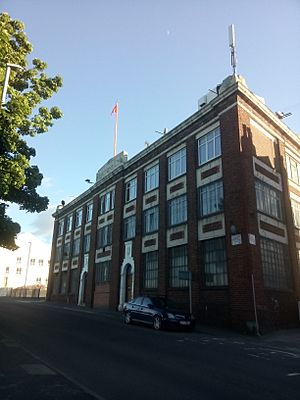Beeston, Leeds facts for kids
Quick facts for kids Beeston |
|
|---|---|
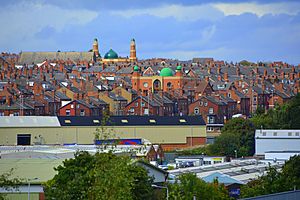 View over Beeston |
|
| Population | 22,187 (2011 Census) |
| OS grid reference | SE294313 |
| Metropolitan borough | |
| Metropolitan county | |
| Region | |
| Country | England |
| Sovereign state | United Kingdom |
| Post town | LEEDS |
| Postcode district | LS11 |
| Dialling code | 0113 |
| Police | West Yorkshire |
| Fire | West Yorkshire |
| Ambulance | Yorkshire |
| EU Parliament | Yorkshire and the Humber |
| UK Parliament |
|
Beeston is a suburb of Leeds, West Yorkshire, England located on a hill about 2 miles (3 km) south of the city centre.
The origins of Beeston can be traced back to the medieval period. It remained a small settlement until the latter part of the Victorian era when it became a primarily residential area for people working in Leeds and surrounding industrial areas like Holbeck and Hunslet.
At the time of the 2011 Census, Beeston had a population of 22,187 (which included Holbeck). Some parts of the area, around Cross Flatts Park, suffer from relatively high levels of deprivation, while areas to the centre and south are generally considered more affluent. Beeston is home to the Leeds United football club stadium on Elland Road and Hunslet rugby league club.
Contents
History
Beeston is first mentioned in the 1086 Domesday Book as Bestone, when it had recently been granted to Ilbert de Lacy (1045–93); in 1066 it had been worth 40 shillings (£2), but in 1086 it was considered waste, presumably because of the Harrying of the North. The name seems to come from Old English *bēos 'bent-grass' (L. Agrostis) and tūn 'estate, village', and the origin of the settlement is likely to be Anglo-Saxon. It was one of the ten 'out-townships' of the Parish of Leeds until the parish was broken up in the 1840s-50s.
In the medieval period, Beeston was associated with sheep-farming: the monks of Kirkstall Abbey grazed 240 sheep there. Founding Drax Priory in the 1130s, William Paynel granted it land in Beeston. A small hospital seems to have been founded in the township around 1233, and a chapel dedicated to St Mary the Virgin may also have been founded in the 13th century.
The oldest buildings in Beeston today date to the 15th century. Cad Beeston (also Cad-Beeston, Cat Beeston, Cat-Beeston) manor house has been dated by dendrochronology to about 1420, and is a grade II* listed building; recently used as private offices, it is now a private dwelling, with no public access. Parts of Stank Hall Barn, a grade II* listed scheduled ancient monument originally built for the storage of crops, have been dated to between 1448 and 1490.
'By the early 17th century the area had a reputation for manufacturing bone lace', and by the middle of the century, coal-mining was underway in the area. According to David Thornton,
in December 1688 rumours abounded in the town [of Leeds] that an army of Roman Catholics were ravaging the surrounding area. Ralph Thoresby recorded, 'Beeston is actually burnt, and only some escaped to bring the doleful tidings! The drums beat, the bells rang backward, the women shrieked, and some doleful consternation seized upon all persons ... (B)lessed be God! The terror disappeared, it being a false alarm, taken from some drunken people.'
Between 1740 and 1820, the Leeds-Elland and Dewsbury-Leeds turnpike roads were built through Beeston; nationalised in the 1870s these roads remain as Elland Road and Dewsbury Road respectively. By 1822, Beeston had a population of 1,670. Up until the 19th century, Beeston had been a small mining village situated on a hill overlooking Leeds. However, during the Industrial Revolution, land that had been occupied by open pits, as well as land formerly utilised for farming, was snapped up for high density residential development. By 1872, Beeston is recorded as having a population of 2,547 with 537 houses, a railway station and a post office, and 'by the end of the 19th century Beeston was predominantly a working class community living in back-to-backs'. Beeston was a township and civil parish 1866-1904, then was absorbed into Holbeck civil parish before this was absorbed into Leeds in 1925.
On the night of 14 March and early hours of 15 March 1941, during the Second World War, Leeds received its worst night of German aerial bombing. Beeston had more bombs dropped on it than any other district of the city and although Flaxton Terrace was damaged during the night time air raid, escaped with the less damage than most other areas of Leeds with nearly all the other bombs landing on Cross Flatts Park. In his 2005 poem "Shrapnel", Tony Harrison, who was in Beeston on the night of the raid, speculates whether this was an act of heroism by the German pilot, a theory that has been explored ever since the raid. Holbeck Cemetery, in Beeston, also features prominently in Harrison's 1985 poem "v".
Beeston was formerly home to card and board game manufacturer Waddingtons, though the factory was vacated in the 1990s, and is now home to Nampak Cartons.
In 2006 the district was the setting for much of the film Mischief Night.
Geography and demographics
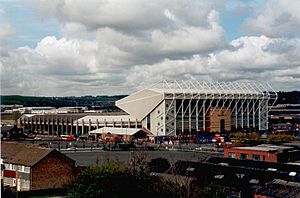
Beeston is an inner-city area located close to Leeds city centre. Beeston is severed from the areas to the north by the M621 motorway. Beeston is separated from Middleton by Middleton Park and from Cottingley by the Leeds Outer Ring Road.
Beeston can be described as three distinct areas. Beeston - Parkside and Cross Flatts area and Beeston Hill are separated by Cross Flatts Park which runs between Dewsbury Road and Town Street: Beeston Hill to the east, and Parkside and Cross Flatts to the west. The distinction between these two areas has probably existed since medieval times when they were two separate manors. Beeston - Elland Road and Millshaw is primarily industrial and centred on Elland Road to the west of the area.
Beeston - Parkside and Cross Flatts area
The Parkside and Cross Flatts area of Beeston, sometimes locally known as Beeston Village, is centred on a shopping centre comprising a Co-operative store and a number of smaller shops. Housing in this part of Beeston is made up of almost equal proportions of late Victorian and early-20th-century terraced housing to the east of Old Lane, and newer semi-detached family and housing association properties to the west. To the south side of Dewsbury Road, there are significant areas of industrial premises.
Indicators for health, economic activity and community safety in this area are broadly consistent with averages for the City of Leeds as a whole.
Beeston Hill area
Beeston Hill is largely made up of areas of older Victoria terraces and newer social housing, which comprises around a third of the housing stock in the area. In April 2008, a £93 million PFI scheme to build 700 private and housing association dwellings and regenerate some existing stock was announced. As a particularly deprived area, Beeston Hill along with Holbeck was the beneficiary of Objective 2 European funding. Beeston Hill has a relatively high level of empty housing as well as a number of significant unoccupied commercial premises. Beeston Hill has a significant ethnic minority population, with around 40% of the population from BME Communities.
The area suffers from a high level of deprivation, with indicators for health, economic activity and community safety substantially worse than for the City of Leeds as a whole.
Beeston - Elland Road and Millshaw Area
The west of Beeston around Elland Road has significant amounts of industrial estates, with a substantial amount of mainly semi-detached and terraced housing to the western edge of the Parkside and Cross Flatts area. This also forms much of the Old Village side of Beeston, as can be seen in many of the houses along Town Street/Milshaw.
Transport
Beeston has a mainline railway line running along its western edge along which all services between Leeds and London King's Cross and London St Pancras run. However, there are no stations along it as Beeston station closed to passengers in 1953. Beeston is served by a number of bus services along Dewsbury Road, Elland Road and Town Street. A general description of these services the following. Firstly, a Park and Ride to Leeds has been built opposite Elland Road Police Station operated by First. First services 2, 12 and 75 link much of Beeston with Middleton, Belle Isle and Hunslet, Arriva buses link the Dewsbury Road/White Rose side of Beeston with Dewsbury, Wakefield, Huddersfield, Heckmondwike and other locations, and the nearby town of Morley has strong bus links to Beeston by way of the following. Service 65 links much of Beeston with Morley and Gildersome, services 51 and 52 link areas close to Elland Road with Morley, and Arriva linking the Dewsbury Road/White Rose side of Beeston to Morley on services 200 and 201. The frequent No 1 bus service, operated by First Leeds largely follows the route of the former Leeds Tramway route 5 through Beeston. and this service continues beyond Leeds to Lawnswood/West Park. The nearest train station to Beeston is Cottingley, which, when walking, is just under a mile away from the Town Street end of Beeston via Crow Nest Lane and using paths through the Cottingley estate, you can also drive to this station within 5 minutes from Town Street. From Cottingley, trains serve Morley, Batley, Dewsbury, Ravensthorpe, Mirfield, Dieghton and Huddersfield making Beeston very accessible by bus and trian from many different locations in Kirklees overall.
Beeston Hill and Beeston is severed from Leeds by the M621 and therefore benefits from very good links with the M621 motorway, as well as the M62, which runs close to Beeston to the south of Morley. There are a few taxi companies serving Beeston, these being Beeston Line, Central Cars, Amber (they bought Gee Gee Cars) and South Leeds.
Local facilities and attractions
Beeston has a range of facilities. It has two large health centres, Elland Road stadium and the John Charles Centre for Sport. Leeds city centre is a short distance away and the M1 and M62 motorways are easily accessed. Cross Flatts Park has many facilities, which include 5-a-side football pitches, tennis courts, two separate play areas one for older children and one for younger children and a bowling green.
Stadia
Beeston is home to two stadiums. Elland Road, home of Leeds United AFC has a 39,640 capacity, all-seater stadium on Elland Road, adjacent to the M621 in the north of Beeston. The South Leeds Stadium, part of the John Charles Centre for Sport is situated on Middleton Grove (off Dewsbury Road) on the southern edge of Beeston. This is home to Hunslet rugby league club, as well as hosting athletics and aquatic sports in the new Aquatic Centre (the replacement for the Leeds International Swimming Pool) which opened in October 2008 and provides an Olympic standard swimming pool and diving pool. The centre also has indoor bowling, indoor Tennis Centre, athletics stadium, rugby pitches and 5-a-side pitches.
Cross Flatts Park
Cross Flatts Park covers an area of 44 acres (17.8 hectares) in the centre of Beeston. While the park formerly suffered from neglect and had a high crime rate, through the work of the Council and community groups such as Friends of Cross Flatts Park and Beeston in Bloom the park has been cleaned up and made safer and more welcoming.
The park has a large multi-use games area which includes five-a-side football pitches, basketball courts and tennis courts, while the park boasts an artificial cricket pitch, a children's play area and outdoor gym equipment. The park is the venue for the Beeston Festival which takes place annually in June, and in summer and school holidays is host to numerous activities for young people. The park hosts a weekly 5 km Parkrun every Saturday morning at 9am, over 1,000 runners have taken part in the event since it began on 30 March 2013.
Holbeck Cemetery
Holbeck Cemetery in Beeston opened in 1857 and closed to general burials in the 1940s. During the period it was operational, thousands of people were buried there with many in 'guinea graves' with several unrelated people buried in the same plot. The graves were so called for the shared headstones on which a single-line inscription cost one guinea (21 shillings).
Henry Rowland Marsden, the Victorian industrialist and former mayor of Leeds, is buried in Holbeck Cemetery where his family grave is marked by a Grade II-listed memorial.
The poem 'v.' by Tony Harrison, published in 1985, describes a visit to Holbeck Cemetery and his reaction to finding his parents' tombstones vandalised.
Greenhouse
In 2008 Shaftesbury House, a working men's hostel designed for the council by George C. Robb in 1936, was converted by Citu to the Greenhouse, an eco-friendly housing project. The building had been empty for a number of years and had previously been earmarked for demolition.
The development, which includes 172 homes, office space and other facilities, is one of the UK's first low-carbon housing developments and incorporates wind turbines, solar panels and ground source heating as well as energy efficient materials and rainwater and greywater recycling. The development has won a large number of awards, including, in 2011, the Regeneration and Renewal Magazine Regeneration Award for Sustainability, with judges praising the holistic way it addressed sustainability and provides real regeneration benefits to a deprived area.
Religious sites
Beeston has at least ten churches of several denominations including Church of England, Roman Catholic, Methodist and Baptist. The Anglican churches of St Mary on Town Street and St Luke on Malvern Road were constructed in the 1870s, though the former is on the site of a much older church. The more modern church of St David Waincliffe on Dewsbury Road, constructed in the 1960s was designed by Geoffrey Davy and won a Hoffman Wood (Leeds) Gold Medal for Architecture.
There are three mosques in Beeston, all located within the Beeston Hill area. There is also a Sikh Gurdwara.
London bombings
Beeston was the focus of press attention following 7 July 2005 London bombings when it was revealed that two of the four bombers had lived in the area. On 12 July, two properties in Beeston were raided by police in connection with the attacks. According to West Yorkshire Police, a significant amount of explosive material was found in the raids and a controlled explosion was carried out at one of the properties.
Location grid
 |
Wortley | Holbeck | Hunslet |  |
| New Farnley, Gildersome | Belle Isle | |||
| Churwell, Morley | Tingley | Middleton |
- Images of England — details from listed building database (465423) Manor House, Cad Beeston; grade II* listed
- Images of England — details from listed building database (465422) Cad Beeston; grade II listed
- The ancient parish of Leeds: historical and genealogical information at GENUKI (Beeston was in this parish).
Economy
Much of Beeston's traditional heavy industry and fabrication works have closed throughout the last forty years. However, there are substantial areas of industrial and commercial development around Elland Road and to the south of Dewsbury Road and Beeston is surrounded by areas which have become popular with businesses, such as Leeds city centre, Tingley and many of the business districts along the south side of the River Aire. The neighbouring White Rose Shopping Centre employs thousands of full- and part-time staff.
Education
Beeston is home to the Leeds College of Technology School of Mechanics situated towards the south side, the Beeston Centre of the Leeds City College (formerly Joseph Priestley College) and Elliott Hudson College. Beeston has one secondary school, Cockburn School which is a specialist arts college. Matthew Murray High School situated between Beeston and Holbeck closed down in 2004 and was merged with Merlyn Rees High School in Belle Isle, to form South Leeds High School in Belle Isle. In September 2009 South Leeds High School was reopened as the South Leeds Academy. In September 2017, South Leeds Academy was renamed and rebranded as Cockburn John Charles Academy, as the Cockburn MAT opened a new school. There are seven primary schools in the area.
Notable people
The playwright Willis Hall attended Cockburn High School in Beeston as did the academic and author of The Uses of Literacy, Richard Hoggart. The poet Tony Harrison was brought up on Tempest Road and went to what was then Cross Flatts county primary school. More recently, the actress Holly Kenny who starred in the BBC drama serial Waterloo Road was a pupil at the school.
The musician and bandleader Ivy Benson grew up in Beeston, where her former house on Cemetery Road is marked with a blue plaque.
Former England and Leeds United footballer Paul Madeley was born in Beeston.
Former international rugby league and rugby union star Jason Robinson went to Cross Flatts Park Middle School and Matthew Murray High School, and began his Rugby League career with Hunslet Hawks.
Leigh Francis, famous for his character Keith Lemon, was born in Beeston.
See also
 In Spanish: Beeston (Leeds) para niños
In Spanish: Beeston (Leeds) para niños




